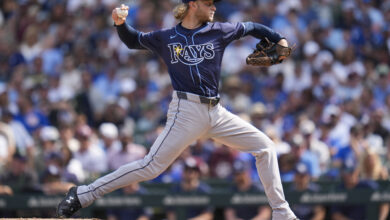
Quantifying Hope: Can Cubs Go First-to-Worst or Secure Top-5 Pick?
Last week’s edition of QH already covered the Cubs’ flatlined playoff odds, so I suppose the title is no longer relevant. As such, this edition is going to look at just how far the Cubs have fallen, along with how much further they could possibly fall. Wait, should it be just how “fur” they’ve fallen? Not only do bears have fur, but that would be a shortened form of the word that means theoretical rather than actual distance.
Wow, I can actually hear people clicking out of the piece. Ludicrous semantic ramblings aside, perhaps it’s more accurate to see how high the Cubs can climb in terms of draft position.
On June 3, they were 10 games over .500 and led the NL Central by 1.5 games over the Cardinals. Chicago was still in first three weeks later, tied with the Brewers and holding a 42-33 record. Six days later, the Cubs were six games back. By the end of July, they were 11.5 off the pace and boasted a stripped-down roster that is hardly able to compete against even mediocre clubs.
The Cubs are now 2-11 since the trade deadline and have lost eight straight games while also dropping their last 10 at Wrigley Field. They are now 18.5 games behind the Brewers following a just-concluded four-game sweep at the hands of the runaway division leaders and only the equally awful Pirates are keeping the Cubs from the bottom.
Things might be different had Pittsburgh gotten hot, but it appears as though they’ll be able to maintain most of their 10-game buffer with the Cubs. However, it’s not out of the realm of possibility that the Cubs could lose 100 games this season. Think about that. With a week left in June, everyone was talking about them being buyers. Now they’ve got a legit shot at being cellars.
With a 52-65 record through 117 games, the Cubs would have to go 10-35 to reach that ignominious century mark. While a .222 winning percentage seems laughably low, it’s nearly 70 points higher than their record since the deadline. It’s also nearly 50 points higher than Ian Happ’s batting average as of this writing. Ah, but 20 of those remaining 45 games come against teams that currently have worse records than the Cubs.
Much of that is because the Cubs were actually good earlier in the season, though, so really face-planting down the stretch means a legit chance at one much bigger number than anticipated and another much smaller. The Cubs currently hold the 10th pick in next summer’s amateur draft, but they are a mere three games away from the No. 5 selection.
Who holds that spot currently? Why, it’s the same Marlins team that will be hosting the Cubs this weekend in Miami. The Cubs then head to Cincinnati, where the Reds are just 3.5 games away from a Wild Card spot. Then the Cubs return home to face the Royals and Rockies, Nos. 6 and 9 in the draft rankings, before taking on the White Sox and the Twins (No. 8 pick).
Other than the Orioles (No. 2) and Pirates, no other team is playing as poorly as the Cubs right now. That means between the mix of contending opponents and fellow tankers — a trend that continues in August — the Cubs could very easily slide into a top-5 spot if they continue to play at a level approaching what we’ve seen of late. As much as that sucks from a competitive standpoint, there’s actually no value in them winning games at this point.
I’m actually a little surprised they released Jake Arrieta rather than giving him a little more runway to see whether he could continue aiding their fiery crash here at the end of the season. Then again, Kyle Hendricks was able to do his best Arrieta impersonation Thursday afternoon as he got shelled by the Brewers in an abbreviated effort.
The only thing standing in the Cubs’ way at this point will be similar attempts by teams like the Nationals, who are also 1-9 over their last 10 and sold off tons of talent at the deadline. This stretch run is going to be like a game of give-away, which for the uninitiated is a derivation of checkers in which the goal is to lose all your pieces first. Games may not be managed specifically to lose, but they’re not going to be managed to win. It’s like spring training except in bigger ballparks.
Not necessarily fuller parks, though, as we’ve seen lately at Wrigley. No longer content with the entropy of the last few seasons, this full-on dive into apathy is going to leave 1060 West Addison nearly empty. Maybe that’s a good thing, since it means the Cubs really can’t afford to let this rebuild drag out over more than another year or so. Those biblical losses will continue if the exodus of fans willing to pay exorbitant ticket prices or watch an inferior product on Marquee stretches much longer.
So there’s your hope, flimsy as it may be. The farm system has gotten much better lately and the nature of the Cubs’ financial model seems to indicate that they’ll have to field at least a mildly competitive team before long, though whether you trust them to do that is another issue entirely.

